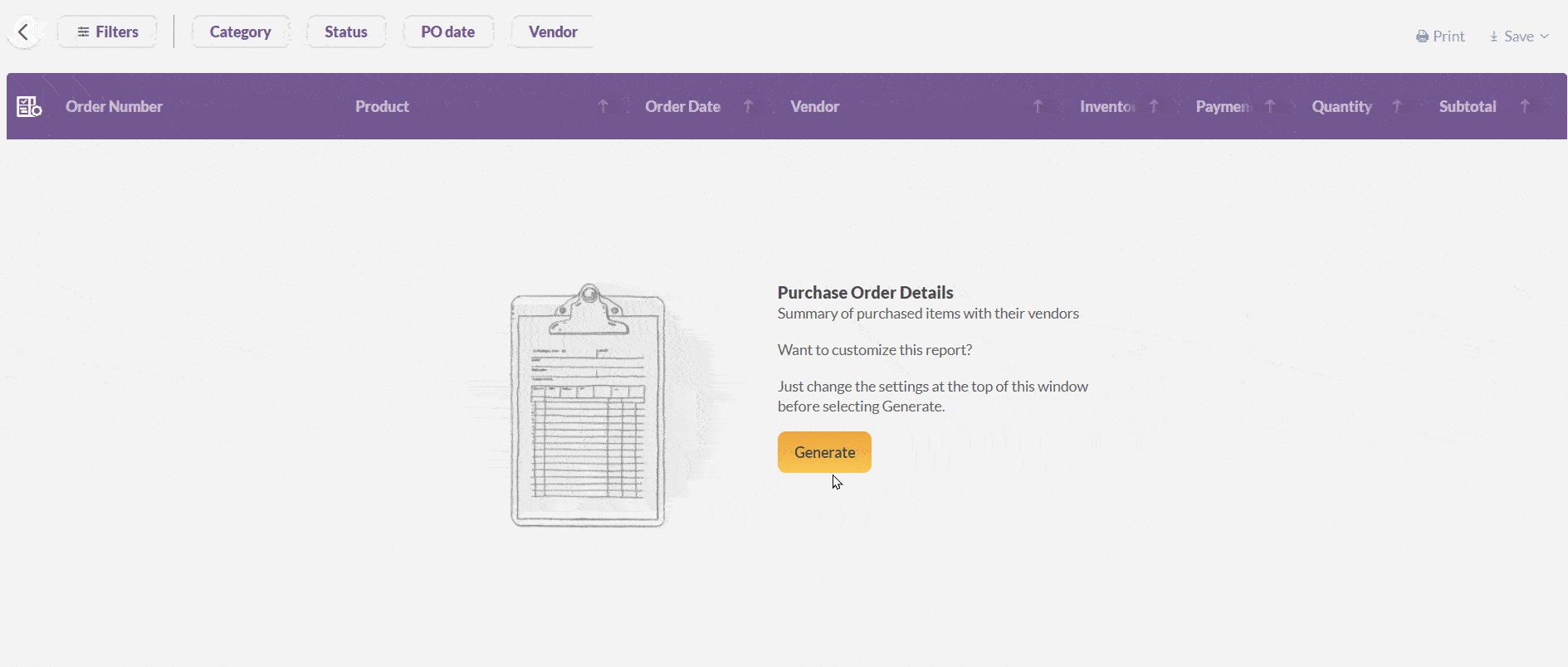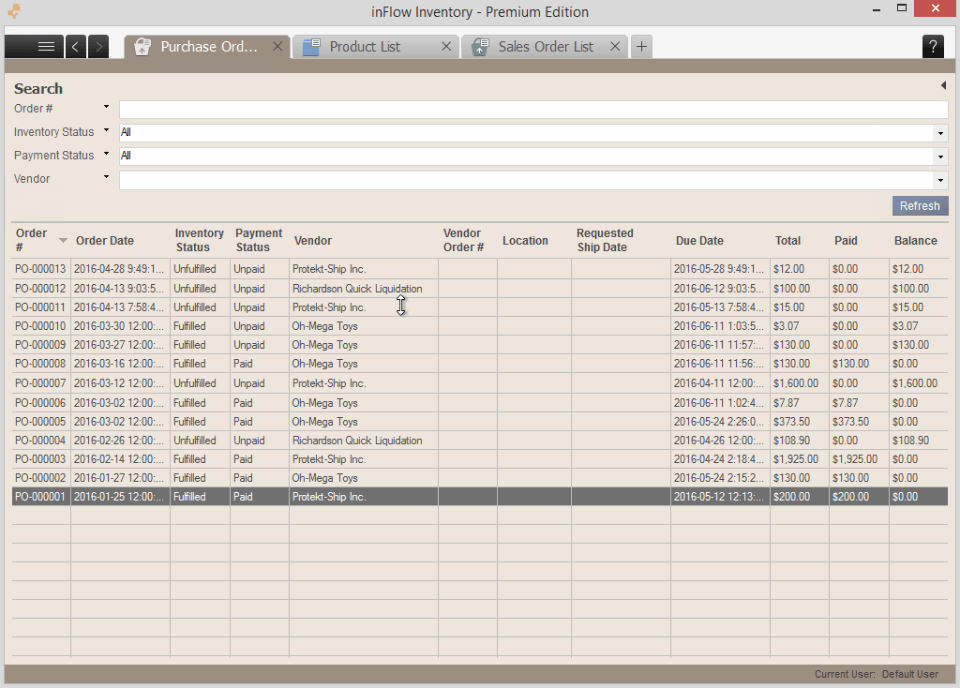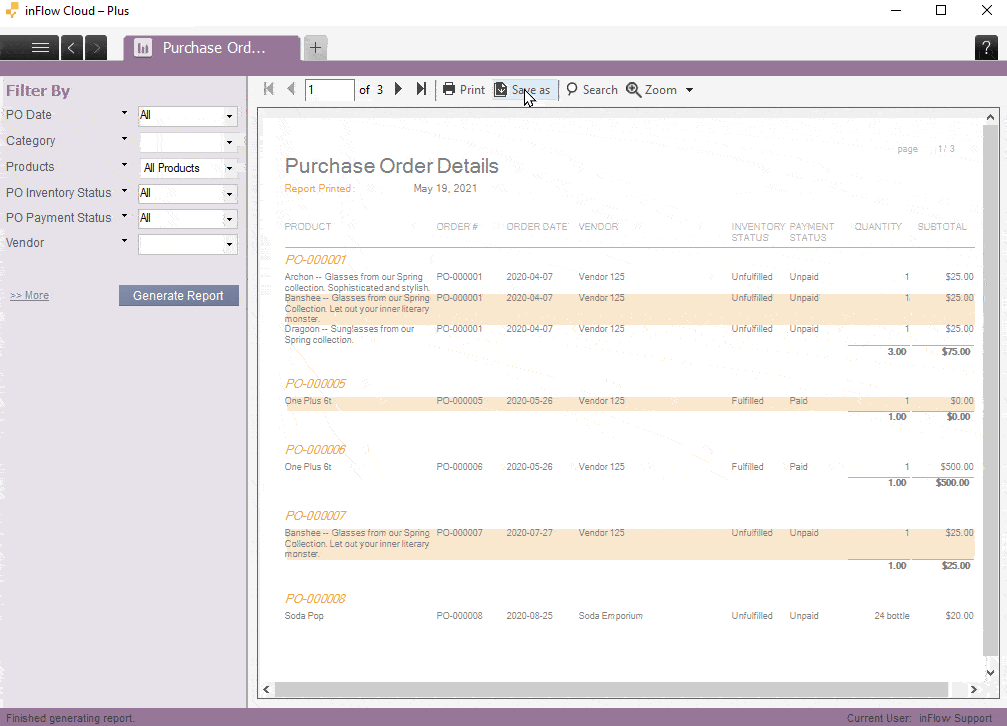How to export data or reports from inFlow
Web
There are two ways to export data: exporting all records of the same type or only certain records of your choice.
What can be exported from inFlow?
- Product details
- Stock levels
- Customers
- Vendors
- Bill of Materials
- Operations
- Sales orders
- Purchase orders
- Language (with inFlow for Windows)
- Reorder settings
- Product images
Please note only inFlow Manufacturing can export bill of materials and operations.
Exporting all data of the same type
To export all data of the same type:
- From the Main Menu, hover over Settings > Export.
- Choose the type of data you’d like to export (Product Details, Stock levels, Customers, Vendors, Sales orders, or Purchase orders)
- Click Export.
- A Save as window will open for you to save your CSV file to your computer. Click Save once you’ve found a location to save your export file, too.
- When done, you will see a message on your screen saying, “Your exported products are ready!“

For example, if you select Product Details to export, this will create a file for all of your products in inFlow (excluding deactivated items). This file will contain information you can get from the product info page, like Price, Cost, Unit of Measure, Barcode, etc.
Exporting reports
If you open up any one of our reports in the inFlow web app, there is the option to save the report as either a PDF file or a CSV file. The default type is a standard PDF format. However, you can also export the data directly to Excel.
To export a report:
- Generate one of inFlow’s many reports.
- At the top right side of the screen, click Save.
- Select your preferred file type.
- The file is then instantly saved to your computer.

Data that can’t be exported
If you’re archiving your database or would like to export as much information out of inFlow as possible, note the following:
- Work Orders can’t be exported – you can note down the details manually if you want to re-create them.
- It’s not possible to export Attachments (product images can be exported.)
- Other than billing and shipping addresses, extra addresses can’t be exported.
- All settings in Personal, General, and Print settings can’t be exported.
Windows
There are two ways to export data: exporting all records of the same type or only certain records of your choice.
What can be exported from inFlow?
- Product details
- Stock levels
- Sales orders
- Purchase orders
- Language
- Bill of materials
- Reorder settings
- Product images
Exporting all data of the same type
- Go to Main Menu > General > Export Data
- Choose the type of data you’d like to export (Product Details, Sales Orders, Purchase Orders, Customers, etc.)
- Click Browse to choose where you’d like this file to be saved.
- Click Export.

For example, if you select Product Details to export, this will create a file for all of your products in inFlow (excluding deactivated products). This file will contain information you can get from the product info page, like Price, Cost, Unit of Measure, Barcode, SKU, etc.
Exporting only a selection of data
If you go to any one of the listing views (e.g., Sales Order List, Purchase Order List, Product List), you can filter that list to show only certain records.
For example, let’s say you want to view and export all products under the “Misc.” category only, you can go to the product list and filter to show only the “Misc.” category products, then export from there. See the GIF below for how to do this (various examples in different lists).
- Go to the listing view of your choice (Sales Order list/ Purchase Order list/ Product list)
Filter this list to the information you want to view / export. - Right-click on the header of the table.
- You can choose two options here:
Export contents to CSV: This exports only the information in the columns that you are seeing in the list view.
Export these orders/products: This exports all information about the products regardless of what columns you have (e.g., Barcode, Cost, Unit of Measure).
For example, the Cost information is not an available column in the Product List. If you are exporting a selection of products and you need to see the cost, you’ll need to click Export these products.

You can also export: Count Sheets, Stock Adjustments, Product Pricing Sheets, Customer Lists, Vendors Lists, and Current Stock Lists
Exporting reports
If you open up any one of our reports in inFlow, there is the option to save the report as a number of different file types. The default type is a standard PDF format. However, you can also export the data directly to Excel.
- Generate one of inFlow’s many reports.
- Go to Save as in the action bar.
- Click Save as type and choose “CSV file” from the dropdown.
- Save!

Data that can’t be exported
If you’re archiving your database or would like to export as much information out of inFlow as possible, note the following:
- Work Orders can’t be exported – you can note down the details manually if you want to re-create them.
- It’s not possible to export Attachments and Pictures/Images
- Other than billing and shipping addresses, extra addresses can’t be exported.
- All settings in Personal, General, and Print settings can’t be exported


0 Comments